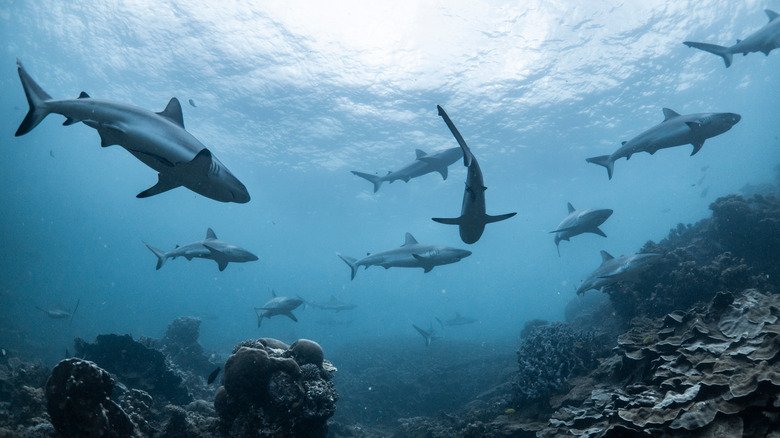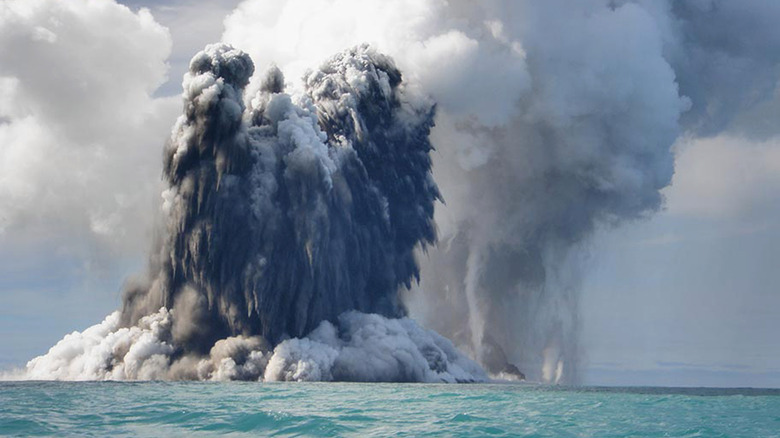The Volcano Full Of Sharks That NASA Saw Erupting From Space
Sharks are all the rage these days. We can thank Steven Spielberg and his 1975 movie "Jaws" for literally launching an entire genre dedicated solely to the fish with the feared fin. Today we have a whole week of Discovery Channel shows dedicated to them. Syfy produced so many schlocky-made-for-TV movies about sharks and tornados that they literally jumped themselves (i.e. "jumped the shark").
Well, now you can see a "Sharkcano," and it's a real thing — sort of.
East of Papua New Guinea, northwest of Fiji, some 1,243 miles off the northeast coast of Australia, lies the archipelagic state known as the Solomon Islands. Amidst it sits Kavachi Volcano, one of the most active underwater volcanoes in the southwestern Pacific. In fact, it's been perpetually spewing steam and ash since 1939 and is even known to create temporary, ephemeral islands that are washed away by the ocean. According to Space.com, it's located a mere 18 miles from a subduction zone rife with tectonic activity.
Honestly, there's nothing particularly unusual about Kavachi. Except during a recent explosion ... sharks came spewing out! Okay, not quite, but they do live inside of it, which is rather peculiar.
Watch for falling sharks
In May of this year, NASA's Operational Land Imager-2 riding aboard the Landsat 9 satellite, managed to snap photos of Kavachi erupting. While the summit is only 65 feet below the surface of the water, the base sits on the seafloor some 3,937 feet (0.75 miles) below.
According to NASA's Earth Observatory, the last time Kavachi had a significant eruption was back in 2014. But it wasn't until 2015 that a research team went to investigate the underwater wonder. The timing of its findings, combined with the relative lack of any significant eruptions, explains why we haven't heard much about sharkcanos ... until now.
The oceanographers discovered that a whole biological ecosystem consisting of gelatinous animals, small fish like Bluefin trevally and snapper, and two (of the over 400) species of shark — the hammerhead and silky — were living quite happily within the bowels of Kavachi.
🦈 You’ve heard of sharknado, now get ready for sharkcano.
The Kavachi Volcano in the Solomon Islands is home to two species of sharks. It’s also one of the most active submarine volcanoes in the Pacific, seen here erupting underwater by #Landsat 9.https://t.co/OoQU5hGWXQ pic.twitter.com/vEdRypzlgi
— NASA Goddard (@NASAGoddard) May 22, 2022
Hydrothermal plumes found within other undersea volcanoes are believed to contain superheated hazy clouds of "particulate matter" with boosted levels of helium (3He) and sulfur, but also with weakened pH values (via Earth Observatory). In fact, one diver during the mission experienced pain when his exposed skin came into contact with the acidic outer line of bubbles in the plume.
Oceanographers have, as a result, taken a deeper look into the adaptability of marine animals. If sharks and other marine life can survive and even thrive in such extreme conditions, it has also given them hope that despite what man does to the planet and its oceans, nature will always find a way.
And we certainly hope a deluge of "Sharkcano" movies aren't far behind.

